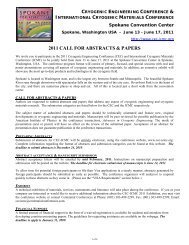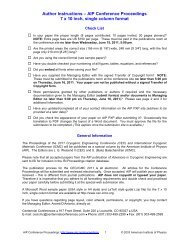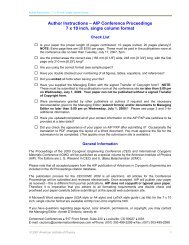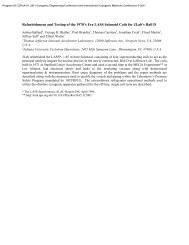CEC Abstracts in PDF format (as of 7/3/07) - CEC-ICMC 2013
CEC Abstracts in PDF format (as of 7/3/07) - CEC-ICMC 2013
CEC Abstracts in PDF format (as of 7/3/07) - CEC-ICMC 2013
Create successful ePaper yourself
Turn your PDF publications into a flip-book with our unique Google optimized e-Paper software.
<strong>CEC</strong> 20<strong>07</strong> - <strong>Abstracts</strong><br />
C1-H-02 Application <strong>of</strong> Novel Regenerator Material<br />
With<strong>in</strong> a Coaxial Two-Stage Pulse Tube Refrigerator<br />
T. Koettig, F. Richter, R. Nawrodt, M. Thuerk, P.<br />
Seidel, Friedrich-Schiller-University Jena.<br />
We have developed a lead-b<strong>as</strong>ed regenerator material which is<br />
suitable for work<strong>in</strong>g temperatures below 20 K. This material can be<br />
used <strong>as</strong> a substitute for the state <strong>of</strong> the art materials used today with<strong>in</strong><br />
very low-temperature regenerators. This high efficient regenerator<br />
matrix comb<strong>in</strong>es technological advantages with the possibility to vary<br />
the thermodynamic and flow characteristics over a wide range,<br />
cont<strong>in</strong>uously. Hence, our self-made electroplated screen material is<br />
compared with standard regenerator materials (commercially available<br />
woven screens and packed spheres). The gap between matrix<br />
porosities <strong>of</strong> standard screens around 0.65 and the porosity <strong>of</strong> packed<br />
spheres with 0.38 is stepwise <strong>in</strong>vestigated regard<strong>in</strong>g the pressure drop<br />
and heat transfer characteristic. The design parameters and the<br />
<strong>in</strong>fluenc<strong>in</strong>g variables to optimise the regenerator performance will be<br />
discussed. The utility <strong>of</strong> the shop-made lead coated regenerator<br />
material is demonstrated <strong>in</strong> a coaxial two-staged pulse tube<br />
refrigerator with work<strong>in</strong>g temperatures below 7 K.<br />
C1-H-03 The Impact <strong>of</strong> Uncerta<strong>in</strong>ties Associated with<br />
Regenerator Closure Parameters on the Predicted<br />
Performance <strong>of</strong> Pulse Tube and Stirl<strong>in</strong>g Cryocoolers<br />
J.S. Cha, W.M. Clearman, S.M. Ghia<strong>as</strong>iaan, P.V.<br />
Desai, G.W. Woodruff School <strong>of</strong> Mechanical<br />
Eng<strong>in</strong>eer<strong>in</strong>g Georgia Institute <strong>of</strong> Technology.<br />
Recent <strong>in</strong>vestigations have shown that computational fluid dynamics<br />
(CFD) techniques can be used for model<strong>in</strong>g the entire pulse tube<br />
(PTR) and Stirl<strong>in</strong>g cryocooler systems. However, the results <strong>of</strong> CFD<br />
simulations can be trusted only if they are b<strong>as</strong>ed on correct closure<br />
relations. The hydrodynamic and heat transfer parameters <strong>as</strong>sociated<br />
with regenerators are among the most important and poorlyunderstood<br />
closure relations for these cryocooler systems. In this<br />
<strong>in</strong>vestigation the impact <strong>of</strong> uncerta<strong>in</strong>ties <strong>as</strong>sociated with flow<br />
resistance parameters, <strong>as</strong> well <strong>as</strong> solid-fluid heat transfer coefficients,<br />
on the performance <strong>of</strong> PTR and Stirl<strong>in</strong>g cryocoolers is exam<strong>in</strong>ed us<strong>in</strong>g<br />
CFD simulations. This objective is achieved by perform<strong>in</strong>g<br />
simulations where reference PTR and Stirl<strong>in</strong>g cryocooler systems<br />
operat<strong>in</strong>g <strong>in</strong> steady-periodic conditions are modeled <strong>in</strong> their entirety.<br />
The effects <strong>of</strong> uncerta<strong>in</strong>ties <strong>in</strong> the regenerator closure parameters on<br />
the cryocoolers performance parameters, <strong>as</strong> well <strong>as</strong> their key local<br />
hydrodynamic and heat transport processes, are quantified by the<br />
parametric variation <strong>of</strong> the aforementioned regenerator closure<br />
parameters.<br />
C1-H-04 New Thermoacoustic Model, New Me<strong>as</strong>urement<br />
Pr<strong>in</strong>ciple and Experimental Results <strong>of</strong> Flow<strong>in</strong>g and Heat<br />
Transfer Characteristics <strong>of</strong> Regenerator<br />
Y.Y. Chen, Graduate University <strong>of</strong> Ch<strong>in</strong>ese Academy<br />
<strong>of</strong> Sciences; E.C. Luo, Technical Institute <strong>of</strong> Physics<br />
and Chemistry, CAS; W. Dai, Technical Institute <strong>of</strong><br />
Physics and Chemistry,CAS.<br />
Regenerators play key role <strong>in</strong> oscillat<strong>in</strong>g-flow cryocoolers or<br />
thermoacoustic heat eng<strong>in</strong>e systems. However, their flow<strong>in</strong>g and heat<br />
transfer mechanism is still not well understood. In this paper, the<br />
authors present a new methodology for study<strong>in</strong>g flow<strong>in</strong>g and heat<br />
transfer characteristics <strong>of</strong> the oscillat<strong>in</strong>g flow regenerator. First we<br />
will present a new thermoacoustic model for oscillat<strong>in</strong>g-flow<br />
regenerator. In the model, the local flow and heat transfer<br />
performance <strong>of</strong> the regenerator can be characterized by its equivalent<br />
thermoacoustic viscous and thermal functions, and a dimensionless<br />
local averaged temperature gradient. Then, we present a simple<br />
acoustical method and experimental system to get the functions. Here,<br />
pressure me<strong>as</strong>urements and velocity me<strong>as</strong>urements by hot wire<br />
anemometry were performed with different screen-packed<br />
regenerators to obta<strong>in</strong> the two functions. With the two me<strong>as</strong>ured<br />
functions, local flow<strong>in</strong>g friction factor and heat transfer coefficient<br />
with<strong>in</strong> the regenerators where mean temperature gradient exists can be<br />
predicted. F<strong>in</strong>ally, local flow<strong>in</strong>g and heat transfer coefficients are<br />
summarized with several dimensionless groups for general and<br />
convenient us<strong>in</strong>g.<br />
This work w<strong>as</strong> supported by the Natural Science Foundation <strong>of</strong><br />
Ch<strong>in</strong>a(Grant No.50625620)<br />
C1-H-05 Longitud<strong>in</strong>al Hydraulic Resistance Parameters<br />
<strong>of</strong> Cryocooler and Stirl<strong>in</strong>g Regenerators <strong>in</strong> Periodic Flow<br />
J.S. Cha, S.M. Ghia<strong>as</strong>iaan, P.V. Desai, G.W.<br />
Woodruff School <strong>of</strong> Mechanical Eng<strong>in</strong>eer<strong>in</strong>g Georgia<br />
Institute <strong>of</strong> Technology.<br />
The results <strong>of</strong> an on go<strong>in</strong>g research program aimed at the<br />
me<strong>as</strong>urement and correlation <strong>of</strong> anisotropic hydrodynamic parameters<br />
<strong>of</strong> widely-used cryocooler regenerator fillers are presented. The<br />
hydrodynamic parameters <strong>as</strong>sociated with longitud<strong>in</strong>al steadyperiodic<br />
flow are addressed <strong>in</strong> this paper. An experimental apparatus<br />
consist<strong>in</strong>g <strong>of</strong> a cyl<strong>in</strong>drical test section packed with regenerator fillers<br />
is used for the me<strong>as</strong>urement <strong>of</strong> axial permeability and Forchheimer<br />
coefficients, with pure helium <strong>as</strong> the work<strong>in</strong>g fluid.The regenerator<br />
fillers that are tested <strong>in</strong>clude sta<strong>in</strong>less steel 400-mesh screens with<br />
69.2% and 62% porosity, sta<strong>in</strong>less steel 325-mesh screens with 69.2%<br />
and 62% porosity, sta<strong>in</strong>less steel 400-mesh s<strong>in</strong>tered filler with 62%<br />
porosity, and sta<strong>in</strong>less steel s<strong>in</strong>tered foam metal with 56% porosity.<br />
The test section is connected to a Stirl<strong>in</strong>g type compressor on one end<br />
and to a constant volume chamber on the other end. The<br />
<strong>in</strong>strumentation <strong>in</strong>cludes piezoelectric pressure transducers at both<br />
ends <strong>of</strong> the regenerator. For each filler material, time histories <strong>of</strong> local<br />
pressures at both ends <strong>of</strong> the regenerator are me<strong>as</strong>ured under steady<br />
periodic conditions over a wide range <strong>of</strong> oscillation frequencies. A<br />
CFD <strong>as</strong>sisted methodology is then used for the analysis and<br />
<strong>in</strong>terpretation <strong>of</strong> the me<strong>as</strong>ured data. The permeability and<br />
Forchheimer parameter values obta<strong>in</strong>ed <strong>in</strong> this way are correlated <strong>in</strong><br />
terms <strong>of</strong> the relevant dimensionless parameters.<br />
C1-H-06 A new correlation <strong>of</strong> friction factor for<br />
oscillat<strong>in</strong>g flow regenerator operat<strong>in</strong>g at high frequencies<br />
Y.L. Ju, Q.Q. Sheng, Shanghai Jiaotong University.<br />
Regenerator plays an important role on the performance <strong>of</strong> low-power<br />
cryocoolers, <strong>in</strong> particular at high operat<strong>in</strong>g frequencies. The ability to<br />
accurately predict the pressure drop and ph<strong>as</strong>e shift across the<br />
regenerator is directly related to the cool<strong>in</strong>g capacity and efficiency <strong>of</strong><br />
a cryocooler. Many works have revealed that the friction factors under<br />
unidirectional steady flow conditions are unsuccessful <strong>in</strong> predict<strong>in</strong>g<br />
the flow characteristics <strong>of</strong> regenerators typically operat<strong>in</strong>g at<br />
oscillat<strong>in</strong>g flow and pulsat<strong>in</strong>g pressure conditions. Recent researches<br />
have been conducted, us<strong>in</strong>g both theoretical analyses and<br />
experimental me<strong>as</strong>urements, either to correlate the conventional<br />
friction factor by <strong>in</strong>troduc<strong>in</strong>g additional parameters or to develop new<br />
flow models to overcome the shortcom<strong>in</strong>g <strong>of</strong> the steady-flow friction<br />
factor. However, validation and application <strong>of</strong> these results for<br />
cryocooler regenerators are still questionable because <strong>of</strong> the complex<br />
and randomly oriented matrix geometry <strong>of</strong> actual regenerators. In this<br />
paper, we will first summary typical experimental results and<br />
correlations on the friction factor <strong>of</strong> regenerators for different sizes <strong>of</strong><br />
packed woven screens, at different frequencies, at room and cryogenic<br />
temperatures. The comparison <strong>of</strong> those friction factor data will then be<br />
presented to clarify the re<strong>as</strong>on for their difference. F<strong>in</strong>ally, a new<br />
correlation <strong>of</strong> friction factor for oscillat<strong>in</strong>g flow regenerator, <strong>in</strong> terms<br />
<strong>of</strong> two non-dimensional parameters, will be presented.<br />
Page 8 <strong>of</strong> 53






